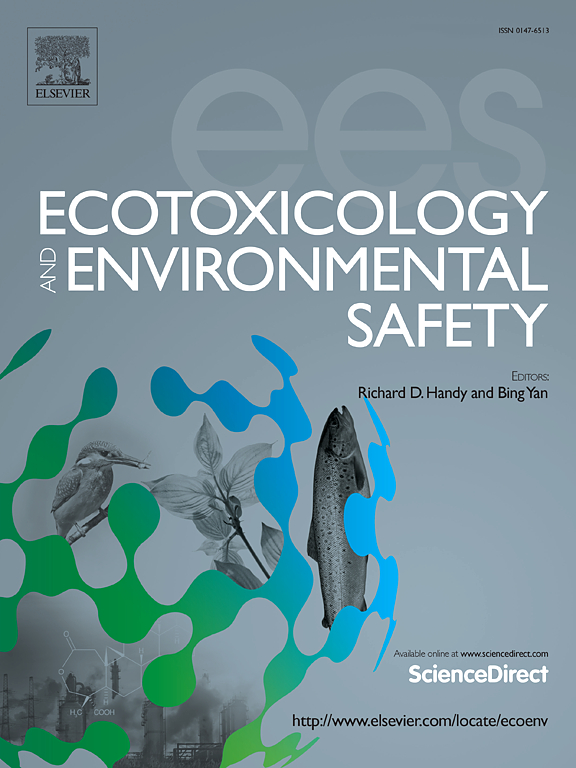Deciphering low-dose radiation-induced cytotoxic effects:The application of integrative transcriptomics and metabolomics analysis in lung organoid-based 3D in vitro model
IF 6.2
2区 环境科学与生态学
Q1 ENVIRONMENTAL SCIENCES
引用次数: 0
Abstract
Although the adverse effects induced by acute high-dose radiation from nuclear accidents have been intensively explored, the biological effects of low-dose radiation remain unclear. This study aimed to identify the role of low-dose radiation in three-dimensional (3D) lung organoids using transcriptomic and metabolomic analyses. An irradiation dose of 0 01 Gy was utilized to simulate environmental radiation exposure. Lung organoids were included in the study. Through metabolomic analysis, compared to the control, 290, 284, and 492 metabolites were significantly up-regulated, while 150, 605, and 310 metabolites were significantly down-regulated in the 0.01 Gy, 0.05 Gy, and 2 Gy groups, respectively. However, only the metabolites in the glycerophospholipid metabolism pathway increased significantly in the group treated with 0. 01 Gy radiation, with the lipid substances Carnitine C18:0(Car (18: 0)), palmitoylcarnitine, and PE (18: 3 (9 Z, 12 Z, 15 Z)/P- 16: 0) showing the most significant increase. Significantly, compared to the control, lipid metabolism can be affected by 0.01 Gy radiation. Furthermore, these altered lipid metabolites, such as triglycerides and sterols, were enriched in pathways related to cell signaling and affected cell proliferation, differentiation, and death after bioinformatics analysis. Through transcriptomic analysis, compared with the 0 Gy group, the expression of 19 genes in the 0.01 Gy group was up-regulated, while the expression of 6 genes was down-regulated. The 0.01 Gy irradiation affects the cardiac muscle contraction pathway and glycerolipid metabolism pathway. Moreover, using lung epithelial cells, we further identified that compared with the control group, there was no significant change in cystine uptake capacity, lipid peroxide levels, or mitochondrial membrane potential under irradiation conditions of 0.01 Gy and 0.05 Gy. In summary, our combined transcriptomic and metabolomic analysis of lung organoids provides an effective approach to understanding the biological effects of low-dose radiation exposure.
破译低剂量辐射诱导的细胞毒性效应:整合转录组学和代谢组学分析在肺类器官三维体外模型中的应用
尽管人们对核事故急性高剂量辐射的不良反应进行了深入研究,但对低剂量辐射的生物学效应仍不清楚。本研究旨在通过转录组学和代谢组学分析确定低剂量辐射在三维(3D)肺类器官中的作用。采用0.01 Gy的辐照剂量模拟环境辐射照射。肺类器官也包括在研究中。通过代谢组学分析,与对照组相比,在0.01 Gy、0.05 Gy和2 Gy组中,有290、284和492种代谢物显著上调,150、605和310种代谢物显著下调。然而,在0。01 Gy辐射后,肉毒碱C18:0(Car(18:0))、棕榈酰肉毒碱和PE (18:3 (9 Z, 12 Z, 15 Z)/P- 16:0)的脂质物质增加最为显著。显著地,与对照组相比,0.01 Gy辐射可影响脂质代谢。此外,生物信息学分析表明,这些改变的脂质代谢物,如甘油三酯和甾醇,在细胞信号传导相关途径中富集,并影响细胞增殖、分化和死亡。通过转录组学分析,与0 Gy组相比,0.01 Gy组有19个基因表达上调,6个基因表达下调。0.01 Gy辐照影响心肌收缩途径和甘油脂代谢途径。此外,利用肺上皮细胞,我们进一步发现,与对照组相比,在0.01 Gy和0.05 Gy的照射条件下,胱氨酸摄取能力、脂质过氧化水平或线粒体膜电位没有显著变化。总之,我们对肺类器官的转录组学和代谢组学联合分析为了解低剂量辐射暴露的生物学效应提供了一种有效的方法。
本文章由计算机程序翻译,如有差异,请以英文原文为准。
求助全文
约1分钟内获得全文
求助全文
来源期刊
CiteScore
12.10
自引率
5.90%
发文量
1234
审稿时长
88 days
期刊介绍:
Ecotoxicology and Environmental Safety is a multi-disciplinary journal that focuses on understanding the exposure and effects of environmental contamination on organisms including human health. The scope of the journal covers three main themes. The topics within these themes, indicated below, include (but are not limited to) the following: Ecotoxicology、Environmental Chemistry、Environmental Safety etc.

 求助内容:
求助内容: 应助结果提醒方式:
应助结果提醒方式:


